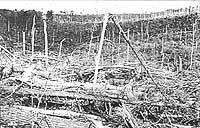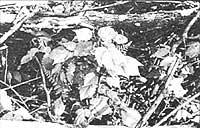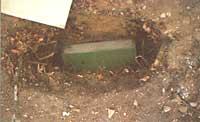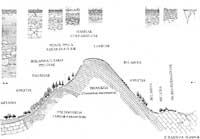How does the forest grow?
1988/02/01 Juandaburre, B. Iturria: Elhuyar aldizkaria

One of the most important questions is how do different types of captivity grow with limited supplies of land, water, and light? The researchers want to know, above all, what happens when the adult trees are removed and only young people and seeds remain. Working with trees is something difficult. In the forestry sector, fires and landslides disrupt the entire ecosystem and trials in greenhouses are artificial and limited. Now North American researchers have sought an appropriate natural laboratory in a manpower destroyed by a tornado.
On May 30, 1985, a group of tornadoes toured the east of the North American state of Ohio. In it is the national park and the forest of Alleghany, two of the lathes that passed through this park. These tornadoes removed the trees from their roots. Chris Peterson, a researcher at the University of New Jersey, is conducting an ecological study of the consequences in the Tionesta region of this forest. The ionesta is, moreover, the largest virgin forest in the east of the US.
In July 1986 Peterson chose three lines of one kilometer in length with a deteriorated zone. Each line begins in a full forest, crosses the deteriorated zone and ends on the other side in an unaltered zone. He and his co-workers have analyzed the state of the vegetation in three lines and have marked the sections. After four years, Peterson expects you to know what happens when you remove mature trees in a forest without further changes.
The trees that cover the hills and hills of this region are beautiful, with altitudes greater than 50 m. Canadian Tsuga (Tsuga canadensis) are dominant trees. Other species are the yellow urki ( Betula lutea ), the gerezika urki ( Slow betula ), the beech hostoandia ( Fagus grandifolia ), the black cherry ( Prunus cerotina ) and the maple ( Acer ) three species. The tornado started a lot of mature trees. The trees of less than a meter that have not been destroyed by the fall of the waste were kept harmless. Many fallen trees were between 300 and 400 years old and the young took direct sunlight for the first time.
In the forest, most of the land cover is made up of beech trees. Under the feet of older trees these beech trees grow very slowly. In the areas affected by the tornado, the hayos are the main ones. These will begin now to compete with birches that grow faster and with the black cherry, which grows very fast and quite cutting. If they are defeated by beech trees, they will be dominant next generation trees.
The 1985 tornado is not the only cause of Tionesta. In 1870 another tornado destroyed an area of 120 hectares near the area that is now being studied. In this area, the proportion of black cherry trees is higher than in the surrounding area. However, Peterson does not believe that the forest that is regenerating follows the same path, fauna XIX. Because it has evolved since the last century. Deer deer ( Odocoileus virginianus ) is the only important of today's mammals, as wolves and other predators who controlled their population have been killed by hunters. According to Peterson, he has not seen a vegetable tsuga more than 5 cm tall and that is not eaten by the deer. Tsuga is the most appreciated food of the deer, but they also eat maple and cherry trees. The beech, for its part, will not be in contact and this will give it advantage against other species.

Another factor that can influence this year's competition of species of Tionesta has been the appearance. Portetría blanquecina, whose worm has debastado other North American forests, has been located in the area of the tornado. The worms prefer the beech and oppose the action of the deer. Currently in the area affected by the tornado there are trees that do not have leaves. Many trees are capable of suffering a loss of leaves of a year, but if the worms returned they would die.
Peterson has carefully selected the areas and has selected those that present different conditions of light, soil and drainage. Some of the plantations are in open zone, far from the fallen tree. Others are among a lot of waste. When the wind has uprooted large snakes it has left deep holes. Two years after the storm in these places nothing has grown. The soil has remained under the trees for hundreds of years, so it lacks humus from the surrounding soil. In other areas, the corrupt branches and leaves of the waste are enriching the soil. On the contrary, large trunks will remain there between 40 and 60 years. Several areas have been cleaned with waste by Peterson to analyze the impact of this action.
At the age of four, Peterson will have a lot of data that can help understand the booming forest ecology.

Gai honi buruzko eduki gehiago
Elhuyarrek garatutako teknologia





